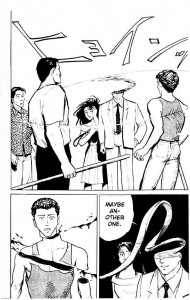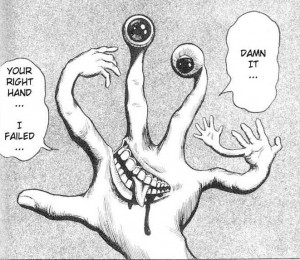Parasyte (vol. 1)
By Hitoshi Iwaaki
Slowly but surely, I’m moving my way up the ranks from manga-noob to manga-novice. For this week, I decided to read Parasyte, a title that is well-regarded by many a manga critic. But you can’t trust the judgment of critics (unless they’re Utilitarians), so I approached this title ready to nit and pick.
It had a simple premise: alien parasites invade Earth and infect the brains of an unknown number of people. But teenager Shinichi Izumi manages to trap a parasite in his right arm before it can enter his head. Now, I’d read enough manga and seen enough anime to know that Shinichi was going to use the parasite in his arm to fight other parasites. The set-up seemed so predictable, and I was considering whether to try out a different book. But then …
On most pages, the art isn’t particularly noteworthy, though it manages to convey the story in a clear manner. But when the parasites reveal themselves, realism gets thrown out the window and the character designs become wonderfully surreal and grotesque. Heads and arms morph into impossible shapes, inflicting gory deaths on a few unlucky humans.
A story about murderous parasites that infect human brains naturally lends itself to horror, but Hitoshi Iwaaki has a gruesome sense of humor. Parasyte gleefully shifts from horror to comedy to action and back to horror in every chapter. The one constant factor is freaky visuals.
At the core of this weird story is the complex relationship between Shinichi and his parasite, Migi (meaning “right”). The textbook definition of a parasite is an organism that benefits at the expense of its host. But in Shinichi’s case, the relationship between host and parasite is almost symbiotic. Migi can’t survive without Shinichi as a host, and so Migi defends Shinichi from all threats, ranging from bullies to other parasites trying to kill him. But co-dependency doesn’t equal friendship. Migi is completely amoral and will do whatever it takes to survive, and Shinichi is not exactly pleased to have a shape-changing parasite in his right hand.
Over time, their symbiosis changes both of them. Migi starts to exhibit human characteristics, and may even care about Shinichi for reasons besides self-preservation. On the other hand, Shinichi begins to wallow in homicidal thoughts.
While I was correct in assuming that the chapters would mostly be about Shinichi and Migi fighting other parasites, the tension between the characters and the ambiguous nature of their relationship keeps the fights from becoming repetitive. Migi defends Shinichi and kills other parasites only because it’s in Migi’s own interest to do so, and it’s quite willing to use innocent people as human shields. Yet when given the choice to abandon Shinichi for a better body, Migi refuses. Shinichi is far more altruistic than Migi, as he doesn’t want innocent people to get hurt. But he also fantasizes about becoming a hero by killing the other parasites.
Overall, a very compelling first volume. Of course, it’s possible that this manga will go completely off the rails in the next volume, but I’ll take my chances.




Parasyte pretty much just keeps getting better and better…until the very end, which is not so great. But even with that minor disappointment, it’s one of my favorite manga series.
As an example, the relationship between Shin and Migi gets increasingly complicated; their identities blur in some disturbing ways. It becomes a meditation on what is and isn’t human, in the vein of (though with somewhat different inflection from) great paranoid Western horror like the Thing and Body Snatchers. It’s a very worthy addition to that pantheon.
Now that you mention it, the body mutations are very similar to The Thing, though the parasites in this story seem much more creative. Honestly, this entire post could have been “look at this cool panel! And this one! And now the dog has wings coming out of its head!”
I’m glad to hear the book lives up to its potential … until the end. Argh, why do so many good series screw up the end?!
It’s the desire to have everything finish up happily. Kills you every time.
That said, there are, as is usual with these things, a couple of “endings”, and all except the last are pretty great.
Pingback: The flaws of Dr. Tenma « MangaBlog
Yeah, I’ve read about 5 volumes of this and it stayed at a fairly high level through all of them, in all the ways you describe — somewhat predictable at times, with generic art in some places, but redeemed by the interesting man/parasite personality tensions and, especially, those amazing bursts of art when the parasites really cut loose. My one complaint is that it all gets a little repetitive: I stopped reading at this point because I felt like not much was being added. I may pick it up again at some point, though.